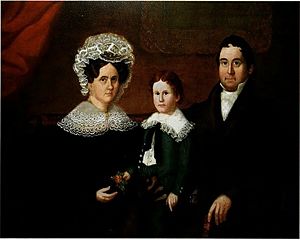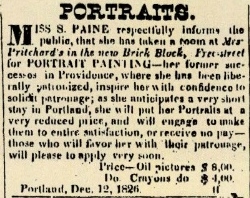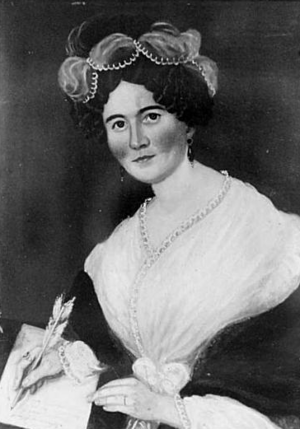Susanna Paine facts for kids
Quick facts for kids
Susanna Paine
|
|
|---|---|
| Born | June 9, 1792 |
| Died | November 10, 1862 (aged 70) Providence, Rhode Island
|
| Nationality | American |
| Known for | Portraits |
| Spouse(s) | James Phillips (1819–1823, divorced) |
Susanna Paine (June 9, 1792 – November 10, 1862) was an American portrait artist. She lived and worked in New England during the 1800s. Besides painting, she also wrote poetry, a Christmas hymn, a novel, and her own life story called Roses and Thorns, or Recollections of an Artist.
Susanna was a very bright student when she was young. However, she had to leave school at age 11 to help care for her sick grandmother. Later, at 15, she became a teacher. A year after that, she went to an academy in Providence, Rhode Island. She paid for her studies by making and selling needlework. She graduated with top honors and then opened her own school. Susanna gave the money she earned to her family, helping them for most of her life.
She had a short marriage and a son who sadly passed away when he was 11 months old. Susanna left her husband before her son was born and later got a divorce. To support herself, she taught for a while. Then, she started working as a portrait painter. From 1826 to 1862, she traveled across Rhode Island, Massachusetts, and Maine. She painted portraits for many people and families. Because she moved around a lot, she didn't have many close, long-lasting friendships. Her closest relationship was with her mother. She also raised a young girl for three years and taught her how to paint. Susanna had times when she was financially secure, but her money and health often changed throughout her career.
Contents
Susanna Paine's Early Life and Education
Susanna Paine was born in Rehoboth, Massachusetts, on June 9, 1792. She was the second child of James and Mary Chaffee Paine. Her father was a sailor who was lost at sea when Susanna was young. After that, she lived with her grandparents.
Susanna was an excellent student. She went to school until she was 11 years old. Then, she needed to help care for her sick grandmother. The next year, she was almost killed by a lightning strike that hit the person standing next to her. Everyone thought she had died, but she woke up after an hour. She had health issues for several years after this event. In 1808, her mother remarried, and their family moved to a farm in Foster, Rhode Island.
At 15, Susanna started teaching school. Later, she attended a top academy in Rhode Island. She paid for her education by selling her needlework. At the academy, she learned to paint with watercolor. She graduated with the highest honors, ready to teach many subjects. After graduating, Susanna opened a school near her mother's home. She gave all the money she earned from the school to her mother and sometimes loaned it to her stepfather.
Becoming a Professional Artist
Susanna Paine reluctantly married James Phillips in 1819. She later described her marriage as difficult and left her husband after about a year. Three months later, in 1821, her son was born, but he passed away at 11 months old. Susanna was granted a divorce in 1821 or 1823. She was left with no money and lost her property.
Susanna went back to teaching and started painting portraits to earn more money. This allowed her to support herself and send money to her mother and stepfather. Her life had been full of challenges and money worries. Instead of marrying again for financial security, she decided to build a career to support herself.
She worked very hard at her painting. When she finished a picture, she would feel proud of it. Once, her landlady was amazed by one of her paintings, calling it "most excellent." The next day, many people came to see if a woman could really paint such good portraits. They all praised her work, which made her very happy.
Traveling as a Portrait Painter
Susanna Paine became a professional portrait painter by traveling through New England. She would place advertisements in local newspapers to find customers. She was one of only a few women who worked as traveling portrait artists in the early 1800s.
Her career was typical of traveling artists back then. She often worried about getting enough work and faced the constant threat of poverty. She had to move often to find new jobs. This was common for both male and female painters at the time.
Susanna was described as a strong and unique person. She was also an idealist, meaning she believed in high standards. People sometimes criticized her for traveling alone as a woman. However, she found it safe to stay in boarding houses, often with help from "letters of introduction" from trusted people. To be seen as a respected artist, she studied art at the Boston Athenæum. She also stayed in nice boarding houses and became a published writer.
Throughout her career, Susanna usually painted with oil on wood panels. These panels were often painted red, gray-green, or green-blue on the sides and back. The people in her paintings often looked confident, shown from the waist up. Their clothes, hair, and accessories were usually very detailed. Sometimes, the way hands or other objects were placed could look a bit awkward. She often painted her subjects with long hands, light skin, soft eyes, and round faces. Susanna was known to change things in her portraits. For example, she once painted a man with black eyes even though his eyes were gray, because she thought black eyes looked better.
Working in Maine
In 1826, Susanna traveled alone for the first time to Portland, Maine. She placed an advertisement in the Portland Advertiser newspaper. At that time, large oil portraits usually cost $20–$30. But Susanna advertised her large portraits for only $8. When she didn't get any customers, she placed another ad in January. This ad included a testimonial saying her portraits were good likenesses and well done. It also suggested that women might feel proud to support a female artist. Once she painted a picture for her landlady, and neighbors saw it, she started getting many requests for her work.
Susanna worked in southern Maine, Portland, and New Hampshire in 1827 and 1828. At first, she had enough work to rent a furnished room and two offices—one for painting and one to show her portraits. She was a religious woman and started wearing simpler clothes as a spiritual practice. When her health got worse, she had to pay for nursing care, which left her low on money. A friend asked her to return to Providence to paint her dying daughter. Still not well, Susanna stayed there for several months.
Susanna worked as an artist in Maine until about 1831. One of the people she painted in Portland was George Morillo Bartol. His portrait was later sold for over $38,000 in 2011.
Painting in Massachusetts
Around 1832, Susanna received formal art training at the Boston Athenæum. She then spent the next summer in Cape Ann. Susanna was one of the first artists to paint in Cape Ann. She returned there for several years, taking breaks to visit her mother each spring and fall. By 1834, she was in Annisquam on Cape Ann, painting family portraits. She continued to paint on the cape through the 1830s and 1840s. She found it to be a special place. She said the scenery was lovely and the people were just right for her. She felt that no one was very rich or very poor, and everyone seemed equal. Kindness and good will were important parts of their lives.
Susanna raised a girl, whom she called her adopted daughter, from age 12 to 15. During that time, Susanna taught her how to paint. They lived for a few months in Fall River, Massachusetts. During a visit to her mother's farm, Susanna found that her younger half-brother had taken over the farm. Her parents were living in a small out-building. Months later, after her half-brother sold the farm, Susanna found her parents looking sad. She arranged for her mother and stepfather to live in an apartment.
Life in Rhode Island
In 1830, Susanna painted a portrait of author Catharine R. Williams. This portrait was later given to the Rhode Island Historical Society in 1885. From about 1836, Susanna lived in Providence, Rhode Island. She continued to support her parents comfortably. Between 1836 and 1838, she wrote and published a Christmas hymn and some poetry.
She had a successful career until 1842. She left town for her safety during the Dorr Rebellion, a political conflict. She went to Cape Ann and returned to Providence a few months later. She became ill and struggled financially because she couldn't find work in either place. Her mother came to live with her in Providence after her stepfather passed away in 1848. The following March, her mother Mary died while visiting her half-brother. Susanna had supported her parents since she was a teenager.
Later Years and Legacy
Susanna traveled through Maine again, but found it hard to get work without the connections she used to have. So, she returned to Providence. For the first time, she set up her studio in a very respectable commercial building, where she was the only female occupant. She faced professional challenges and also struggled personally after losing her mother. Her career, which required constant travel, made it difficult for her to form lasting friendships. Her relationship with her mother was the only truly close one in her life.
In 1854, she published her autobiography, Roses and Thorns, or Recollections of an Artist. Six years later, she published Wait and See, a Victorian novel. Susanna Paine passed away in Providence, Rhode Island, on November 10, 1862.
Today, papers, photographs, and other materials about Susanna Paine are kept at the Brooklyn Museum Libraries & Archives and the Frick Art Reference Library.
Collections
- Cape Ann Museum, Gloucester, Massachusetts
- Maine State Museum, Augusta, Maine
- Portland Museum of Art, Maine
- Rhode Island Historical Society, Providence, Rhode Island
Works
- Sally Ellery Ryerson Merchant, oil on canvas, c. 1825–1835, Cape Ann Historical Association
- Catherine Read Arnold Williams, oil on wood, c. 1830 John Brown House Museum, Rhode Island Historical Society
- Eliza and Sheldon Battey and their son Thomas Sheldon Battey, Providence, Rhode Island, oil on wood, 1830, private collection
- George Morillo Bartol, pastel on paper, 1827
- Portrait of Mrs. J. H. Corbett, oil on panel, 1832, Portland Museum of Art, Maine
- Gideon Lane, III, oil on wood, 1833, Cape Ann Historical Association
- Hannah Griffin Lane, oil, 1833, Cape Ann Historical Association
- Eliza Harper Peabody Lane, oil on wood, 1833, Cape Ann Historical Association
- Hannah Fuller Smith Stanwood, oil, 1834, Cape Ann Historical Association
- Lucy Kinsman Brown Davis, oil on wood, c. 1835, Cape Ann Historical Association
- The Oldridge Family, four oil on wood panel portraits, 1839, private collection
- Portrait of a Lady in a Lace Cap, oil, Portland Museum of Art






